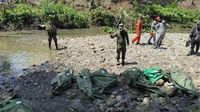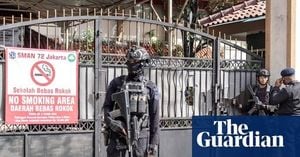Typhoon Kalmaegi, one of the most devastating storms to hit Southeast Asia in recent years, has left a trail of destruction across the Philippines and Vietnam, with the full scale of its impact still coming into focus as authorities scramble to respond. As of November 7, 2025, the storm has left at least 188 dead and 135 missing in the Philippines alone, according to the Office of Civil Defense, while Vietnam has reported additional fatalities and hundreds of thousands evacuated.
Philippine President Ferdinand Marcos Jr. declared a state of national emergency on November 6, following days of relentless rain, flash floods, and landslides. The declaration, announced during a briefing at the National Disaster Risk Reduction and Management Council, is intended to accelerate rescue, relief, and rehabilitation efforts, allowing for faster access to emergency funds and streamlined procurement processes. "Because of the scope of, shall we say, problem areas that has been hit by Tino and will be hit by (Typhoon) Uwan, there was a proposal from the (council), which I approved, that we will declare a national calamity," Marcos said, as reported by Anadolu Agency.
The numbers paint a grim picture. The disaster agency confirmed that, as of November 7, at least 114 people are dead and 127 remain missing—figures that are expected to climb as search and rescue operations continue. In Cebu, the hardest-hit province, the floodwaters have only just begun to recede, revealing flattened homes, overturned vehicles, and streets choked with debris. For many, the return home has been heartbreaking. "The challenge now is debris clearing... These need to be cleared immediately, not only to account for the missing who may be among the debris or may have reached safe areas but also to allow relief operations to move forward," said Raffy Alejandro, a senior civil defence official, in an interview with DZBB radio.
Kalmaegi, locally known as Typhoon Tino, made two landfalls in the Visayas region early Tuesday, November 4—first in Southern Leyte, then in Cebu—before exiting the country on Thursday morning. The storm brought sustained winds of up to 140 km/h (87 mph) and gusts reaching 187 km/h (116 mph), according to the country’s weather agency. The devastation was compounded by the fact that more than 500,000 people have been displaced, and over 1.4 million affected in the Central Visayas region, including parts of Cebu province. The typhoon’s aftermath follows a powerful 6.9 magnitude earthquake that struck Cebu on September 30, killing dozens and displacing thousands, as reported by Anadolu Agency and AP.
In the Philippines, the state of emergency is more than a formality; it unlocks mechanisms for rapid response. Emergency funds can now be disbursed more quickly, and local governments have been empowered to prevent food hoarding and overpricing, both critical in the immediate aftermath of such disasters. Over 200,000 people were evacuated ahead of Kalmaegi’s landfall, but for many, the ordeal is far from over. Nearly 2 million people have been affected, with over 560,000 displaced and nearly 450,000 seeking shelter in emergency facilities. As of Thursday, more than 318,000 were still in evacuation centers, according to the Office of Civil Defense.
The typhoon’s ferocity was not limited to flooding and wind damage. In Central Visayas, 82 people were injured, and widespread power outages left entire communities in darkness. The storm uprooted trees and utility poles, tore off roofs, and triggered landslides that cut off remote areas. Inter-island ferries and fishing boats were banned from operating due to rough seas, stranding more than 3,500 passengers and cargo truck drivers in nearly 100 seaports, according to the coast guard. At least 186 domestic flights were canceled, further complicating relief efforts.
Tragedy struck the Philippine Air Force as well, when a Super Huey helicopter crashed in Agusan del Sur on November 4 while en route to assist provinces battered by the typhoon. All six personnel aboard died, and their remains were recovered from the crash site. The chopper was part of a humanitarian mission to assess the impact of the storm, as confirmed by the air force and multiple news outlets.
Even as Kalmaegi exited the Philippines and moved across the South China Sea, it regained strength before slamming into central Vietnam on November 7. Vietnamese authorities responded with sweeping evacuations—over 537,000 people were moved to safety, many by boat, as floodwaters rose and landslides threatened. In Gia Lai and Dak Lak provinces, state media reported two deaths, while three fishermen went missing off Quang Ngai province after their boat was swept away by strong waves. The search was suspended due to worsening weather.
Kalmaegi was forecast to dump more than 24 inches of rain in some parts of Vietnam, and as it approached, sustained winds reached 183 km/h (114 mph), with gusts up to 220 km/h (137 mph). Waves as high as 3 meters (10 feet) battered coastal cities like Danang, and power outages were reported in Quy Nhon. The country’s financial hub, Ho Chi Minh City, was put on high alert for severe flooding, with high tides expected on the Saigon River and up to 100 millimeters (4 inches) of rainfall threatening low-lying areas.
Vietnamese aviation authorities warned that operations at eight airports, including Da Nang International Airport, could be affected, and airlines were urged to monitor the storm closely. The coffee-growing provinces, crucial during the ongoing harvest, braced for potentially devastating impacts. Meanwhile, Thailand issued advisories for heavy rain and instructed all provincial governors to prepare for possible flooding, especially in the capital, Bangkok.
Back in the Philippines, the government is already bracing for the next blow. State forecasters are tracking Typhoon Uwan (internationally known as Fung-wong), which could reach a staggering 1,400-kilometer (870-mile) diameter and is expected to make landfall in northern Aurora province or nearby regions, potentially impacting the densely populated Manila metropolitan area. President Marcos underscored the urgency: "We suffered many deaths…it was very grave," he said Thursday, adding, "the biggest problem that we’re seeing is, we have to think who and how many of the personnel now handling government relief and support in the central Visayas region can be shifted to prepare for Uwan."
The Philippines, battered by about 20 typhoons and storms each year, is among the world’s most disaster-prone countries. Vietnam, too, faces a relentless cycle of storms and flooding, with scientists warning that climate change is intensifying the frequency and severity of such events across Southeast Asia. In recent weeks alone, Vietnam endured Typhoon Ragasa, Bualoi, and Matmo—storms that together left more than 85 dead or missing and caused an estimated $1.36 billion in damage.
For survivors like Krizza Espra in Cebu, the suffering is personal and raw. She visited a mortuary Thursday to see the bodies of her husband and three children, who died when the roof they sheltered on collapsed. Four other family members remain missing. "I hope someone can help speed up the search for their bodies before (they) decompose, we hope we can still recognize them," she told AP.
As communities across the Philippines and Vietnam begin the long, difficult road to recovery, the region steels itself for whatever nature may bring next. The lessons of Kalmaegi—a storm that revealed both the vulnerability and resilience of millions—will linger long after the floodwaters recede.






